Articles
- Page Path
- HOME > Korean J Community Nutr > Volume 20(4); 2015 > Article
-
Research Article
- A comparison of Dietary Habits and Influencing Factors for Vegetable Preferences of Adolescents in Gyeongnam Province
- Suhyang Kwak, Taejung Woo, Kyoung Ae Lee, Kyung-Hea Lee
-
Korean Journal of Community Nutrition 2015;20(4):259-272.
DOI: https://doi.org/10.5720/kjcn.2015.20.4.259
Published online: August 30, 2015
1Department of Nutrition Education, Graduated School of Education, Changwon National University, Changwon, Korea.
2Department of Food and Nutrition, Changwon National University, Changwon, Korea.
3Department of Practical Arts Education and Centre for Child Nutrition Education, Busan National University of Education, Busan, Korea.
- Corresponding author: Kyung-Hea Lee. Department of Food and Nutrition, Changwon National University, 20 Changwondaehak-ro, Uichanggu, Changwon-si, Gyeongnam 51140, Korea. Tel: (055) 213-3514, Fax: (055) 281-7480, khl@changwon.ac.kr
Copyright © 2015 The Korean Society of Community Nutrition
This is an Open-Access article distributed under the terms of the Creative Commons Attribution Non-Commercial License (http://creativecommons.org/licenses/by-nc/3.0/) which permits unrestricted non-commercial use, distribution, and reproduction in any medium, provided the original work is properly cited.
- 1,531 Views
- 12 Download
- 13 Crossref
Abstract
-
Objectives
- A higher consumption of vegetables is emphasized as the core component of most dietary guidelines. Thus, this research investigated the dietary habits and influencing factors of vegetable preferences of adolescents.
-
Methods
- This study was conducted by using a self-administered questionnaire. 400 students from two high schools in Gyeongnam (193 boys, 207 girls) participated in the survey. The questionnaire consisted of the following variables: dietary habit, dietary action guide and factors based on Social Cognitive Theory (SCT).
-
Results
- The dietary habits of subjects showed significant differences depending on whether they prefer vegetables or not. The subjects in the group who liked vegetables had better dietary habits than the other group. Also, the study determined that the most important reason for liking or disliking vegetables is due to the taste. In the practice of dietary guidelines, the group of subjects who liked vegetables followed dietary guidelines more closely than the other group (p < 0.001). When the factors based on SCT were analyzed, personal factors showed significant differences between the groups: outcome expectation (p < 0.001), self-efficacy (p < 0.001) and affective attitude (p < 0.001). Personal factors and rated vegetable preferences showed a significant correlation in multiple regression analysis (F=42.015, p < 0.001).
-
Conclusions
- These results showed that vegetable preference is associated with a key point of desirable dietary habits among subjects. In order to increase vegetable preference or consumption, it is important to focus on strengthening not only self-efficacy of students, but also affective attitude of vegetable.
- 1. Lee KH, Kim KW, Lee YK, Lee SM, Son SM. Practice in nutrition education & counseling. 3rd ed. Seoul: Life Science Pulishing Co; 2015. p. 31. p. 353-364.
- 2. Cho SH, Yoo HH. Nutrition knowledge, dietary attitudes, dietary habits and awareness of food-nutrition labelling by girl's high school students. Korean J Community Nutr 2007; 12(5): 519-533.
- 3. Korea Center for Disease Control and Prevention. The 10th Korea youth risk behavior web-based survey [internet]. 2014; cited 2015 Feb 10]. Available from: http://yhs.cdc.go.kr.
- 4. Ministry of Health and Welfare. Korea Center for Disease Control and Prevention. Korea health statistics 2013; Korea National Health & Nutrition Examination Survey (KNHANES VI-1) [internet]. 2014; cited 2015 Jan 10]. Available from: http://knhanes.cdc.go.kr.
- 5. Marlett JA. Sites and mechanisms for the hypocholesterolemic actions of soluble dietary fiber sources. Adv Exp Med Biol 1997; 427(1): 109-121.ArticlePubMed
- 6. Jenkins DJ, Kendall CW, Axelsen M, Augustin LS, Vuksan V. Viscous and nonviscous fibers, nonabsorbable and low glycaemic index carbohydrates, blood lipids and coronary heart disease. Curr Opin Lipidol 2000; 11(1): 49-56.PubMed
- 7. Pollard CM, Nicolson C, Pulker CE, Binns CW. Translating government policy into recipes for success! Nutrition criteria promoting fruits and vegetables. J Nutr Educ Behav 2009; 41(3): 218-226.ArticlePubMed
- 8. United States Department of Agriculture. Fresh fruit and vegetable program [internet]. 2002; cited 2015 Feb 1]. Available from: http://www.fns.usda.gov/ffvp.
- 9. Hong JH, Cho MS. Acceptance of vegetable menus of a school lunch program by high school students in Seoul and its association with health and dietary behavioral factors. Korean J Food Sci Technol 2012; 44(1): 121-134.Article
- 10. Ministry of Health, Labour and Welfare. The 2nd Health Japan 21 [internet]. 2013; cited 2015 Feb 1]. Available from: http://www.kenkounippon21.gr.jp.
- 11. Ministry of Health and Welfare. Dietary reference intakes for Koreans. 1st revision. Seoul: The Korean Nutrition Society; 2010. p. 609.
- 12. Ministry of Health and Welfare. Health Plan 2020 [internet]. 2011; cited 2014 Jan 10]. Available from: http://www.mw.go.kr/front_new.
- 13. Kim GR, Park SH, Kim MJ. A survey on intake of vegetable foods for proper dietary habits in middle school students. Korean J Culinary Res 2007; 13(4): 128-137.Article
- 14. Ahn YK, Ro HK. A survey on preferences for vegetable cooking methods and vegetable-aversion-related factors among elementary school students in Kwangju and Chonnam regions. Korean J Community Nutr 2009; 14(5): 531-544.
- 15. Ahn Y, Kim KW. Beliefs regarding vegetable consumption, self-efficacy and eating behaviors according to the stages of change in vegetable consumption among college students. Korean J Community Nutr 2012; 17(1): 1-13.Article
- 16. Ham E, Choi MK. Evaluation of vegetable intakes according to body mass index of adolescents in Chungnam. J Korean Soc Food Sci Nutr 2014; 43(6): 926-933.Article
- 17. Contento IR. Nutrition education-linking research, theory, and practice. 1st ed. Sudbury: Jones and Barlett Publishers; 2006. p. 88-108. p. 91. p. 122. p. 125. p. 117-118.
- 18. Middaugh AL, Fisk PS, Brunt A, Rhee YS. Few associations between income and fruit and vegetable consumption. J Nutr Educ Behav 2012; 44(3): 196-203.ArticlePubMed
- 19. Kim JY. A study on middle school students' preference and perception for vegetables depending on their knowledge of nutrition [master's thesis]. Chungang University graduated school of education; 2013; 58-65.
- 20. Chung SJ. Usage the stage of change model preceed-proceed model. Proceedings of 2006 Workshop of the Korean Society of Community Nutrition; 2006 Feb 2; Seoul. p. 1-10.
- 21. Baek JY, Kim HY. Vegetable eating behavior and preference of elementary school students by stage of change for vegetable intake. Korean J Food Cult 2007; 24(2): 146-154.
- 22. Chung EJ, Lee SH, Ahn HS. Vegetable preferences and their associations with nutritional knowledge and health-related variables in 5th and 6th grade schoolchildren. J Korean Diet Assoc 2009; 15(2): 83-96.
- 23. Jung HK, Jo HJ, Choi MJ. A study on vegetable & fruit eating habits and dietary fiber intake of high school students - focusing on high school students in Daegu -. J Korean Soc Sch Health Educ 2011; 12(3): 43-64.
- 24. Suh Y, Choi A, Chung YJ. Psychosocial factors related with the intake of vegetables and fruits by stage of change of elementary school children in Chungnam province. Korean J Nutr 2009; 42(7): 639-649.Article
- 25. Suh Y, Chung YJ. The effect of nutrition education on the improvement of psychosocial factors related to vegetable and fruit intake of elementary school children in pre-action stages. Korean J Nutr 2010; 43(6): 597-606.Article
- 26. Lanfer A, Bammann K, Knof K, Buchecker K, Russo P, Veidebaum T. Predictors and correlates of taste preferences in European children: The IDEFICS study. Food Qual Prefer 2013; 27(2): 128-136.Article
- 27. Park SH, Park HR, Jeon SB, Jeong SY, Tserendejid Z, Seo JS, Lee KH, Lee YK. Awareness and practice of dietary action guide for adolescence among middle and high school students in Korea. Korean J Community Nutr 2012; 17(2): 133-145.Article
- 28. Cho HS, Choi MK. A study on body image and dietary habits by body mass index of middle school students in Chungnam. Korean J Food Nutr 2010; 23(3): 368-375.
- 29. Park SH, Kim MJ. Acceptance and preference of vegetables in menus for middle school students. J Korean Soc Food Sci Nutr 2008; 37(12): 1660-1666.Article
- 30. Cho HK, Kim MH. Dietary behavior and nutrient intake in university female students according to taste preference. J Korean Diet Assoc 2010; 16(2): 100-115.
- 31. Ku UH, Seo JS. The status of nutrient intake and factors related to dislike of vegetables in elementary school students. Korean J Community Nutr 2005; 10(2): 151-162.
- 32. Wardle J, Cooke LJ, Gibson EL, Sapochnik M, Sheiham A, Lawson M. Increasing children's acceptance of vegetables; a randomized trial of parent-led exposure. Appetite 2003; 40(2): 155-162.ArticlePubMed
- 33. Woo T, Lee KH. Effects of sensory education based on classroom activities for lower grade school children. Nutr Res Pract 2013; 7(4): 336-341.ArticlePubMedPMC
- 34. Woo TJ, Lee KH. Relationship between sweet preferences and motivation factors of 2nd grade schoolchildren. Korean J Food Nutr 2014; 27(3): 383-392.Article
- 35. Kristal AR, Glanz K, Tilley BC, Li S. Mediating factors in dietary change: understanding the impact of a worksite nutrition intervention. Health Educ Behav 2000; 27(1): 112-125.ArticlePubMedPDF
- 36. Liem DG, Mars M, Graaf C. Sweet preferences and sugar consumption of 4-and 5-year-old children: role of parents. Appetite 2004; 43(3): 235-245.ArticlePubMed
REFERENCES
Figure & Data
REFERENCES
Citations

- Development of evaluation items for adolescents’ dietary habits and nutritional practices reflecting eating behaviors and food environment
Jimin Lim, Hye Ji Seo, Jieun Oh
Journal of Nutrition and Health.2024; 57(1): 136. CrossRef - Analysis of socio-demographic and dietary factors associated with fruit and vegetable consumption among Korean adolescents: use of data from the 7th and 8th Korea National Health and Nutrition Examination Survey (2016–2019)
Bokyeong Yun, Seunghee Kye
Journal of Nutrition and Health.2024; 57(3): 292. CrossRef - Factors affecting sugar intake in adults based on the social cognitive theory
Kilye Kim, Yeon-Kyung Lee
Journal of Nutrition and Health.2024; 57(1): 120. CrossRef - Factors influencing the consumption of convenience foods among Korean adolescents: analysis of data from the 15th (2019) Korea Youth Risk Behavior Web-based Survey
Seul Ki Park, Ji Hyun Lee
Journal of Nutrition and Health.2020; 53(3): 255. CrossRef - The Influence of Social Media Affinity on Eating Attitudes and Body Dissatisfaction in Philippine Adolescents
Shannen Tadena, So Ra Kang, Shin-Jeong Kim
Child Health Nursing Research.2020; 26(1): 121. CrossRef - Home Meal Replacement Use and Eating Habits of Adults in One-Person Households
Mi-Kyeong Choi, Eun-Sun Park, Mi-Hyun Kim
Korean Journal of Community Nutrition.2019; 24(6): 476. CrossRef - Relationships among Skeletal Muscle Mass, Health Related Factors, Nutrient Intake, and Physical Activities in Male Adolescents: Based on the 5th (2009-2011) Korean National Health and Nutrition Examination Survey (KNHANES)
In-Kyung Jung, Jung-Hyun Kim
The Korean Journal of Community Living Science.2018; 29(2): 185. CrossRef - Study on Perception and Preference of Vegetable Intake of Alienated Children in Gyeongbuk Area according to Gender and Grade
Won-Hui Choe, Eun-Soon Lyu, Kyung-A Lee
Korean Journal of Food and Cookery Science.2018; 34(4): 394. CrossRef - Analysis of health habit and hair mineral nutrition status of media addicted adolescent
Hee-Sook Lim, Soon-Kyung Kim
Journal of Nutrition and Health.2018; 51(4): 295. CrossRef - Development of NQ-A, Nutrition Quotient for Korean Adolescents, to assess dietary quality and food behavior
Hye-Young Kim, Jung-Sug Lee, Ji-Yun Hwang, Sehyug Kwon, Hae Rang Chung, Tong-Kyung Kwak, Myung-Hee Kang, Young-Sun Choi
Journal of Nutrition and Health.2017; 50(2): 142. CrossRef - Factors affecting vegetable preference in adolescents: stages of change and social cognitive theory
Taejung Woo, Kyung-Hea Lee
Nutrition Research and Practice.2017; 11(4): 340. CrossRef - Status of Dietary Life Related Knowledge, Self-Efficacy, Food Preference and Dietary Behavior of Preschoolers in Kyunggi Area
A Reum Lee, Ye Lee Yu, Hye Jin Kim, Kyung A Kim, Kyung Won Kim
Korean Journal of Community Nutrition.2016; 21(3): 274. CrossRef - Gender Differences in Adolescents' Dietary Perceptions and Practices
Taejung Woo, Hye-Jin Lee, Kyoung Ae Lee, Seung Min Lee, Kyung-Hea Lee
Korean Journal of Community Nutrition.2016; 21(2): 165. CrossRef
Characteristics of the subjects
1) Criterion for dividing the group (Q: Do you like eating vegetables?. A: 'Yes')
2) Criterion for dividing the group (Q: Do you like eating vegetables?, A: 'No')
3) p-value by χ2-test, independent t-test
4) N (%)
5) Mean±SD
Comparison of vegetables preference between the groups
1) Mean ±SD ('1'- strongly dislike, '2'-dislike, '3'-like, '4'- strongly like)
*: p < 0.05, **: p < 0.01, ***: p < 0.001 by independent t-test
The reasons to prefer vegetables of subjects1)
Multiple response, 2) Responses of only vegetable preference group, 3) N (%), 4) Responses of only vegetable non-preference group
Comparison of dietary habits between the groups
N (%), *: p < 0.05, **: p < 0.01, ***: p < 0.001 by χ2-test
Comparison of the practice rate of dietary action guide between the groups
1) Mean ±SD ( '1'- strongly disagree, '2'-disagree, '3'-neither disagree nor agree, '4'-agree, '5'- strongly agree)
*: p < 0.05, **: p < 0.01, ***: p < 0.001 by independent t-test
Comparison of personal factors between the groups
1) Mean ±SD ('1'-strongly disagree, '2'-disagree, '3'-agree, '4'- strongly agree)
*: p < 0.05, **: p < 0.01, ***: p < 0.001 by independent t-test
Comparison of nutrition knowledge between the groups
1) Mean ±SD ('1'-right, '0'-wrong, total score=10)
*: p < 0.05, **: p < 0.01 by independent t-test
Comparison of environmental factors between the groups
1) Mean ±SD ('1'-strongly disagree, '2'-disagree, '3'-agree, '4'- strongly agree)
2) Items reversed for scoring
*: p < 0.05, **: p < 0.01, ***: p < 0.001 by independent t-test
Multiple regression analysis between vegetables preference and influencing factors
Dependent variable : vegetables preference
*: p < 0.05, **: p < 0.01, ***: p < 0.001 by multiple regression analysis
1) Criterion for dividing the group (Q: Do you like eating vegetables?. A: 'Yes') 2) Criterion for dividing the group (Q: Do you like eating vegetables?, A: 'No') 3) p-value by χ2-test, independent t-test 4) N (%) 5) Mean±SD
1) Mean ±SD ('1'- strongly dislike, '2'-dislike, '3'-like, '4'- strongly like) *: p < 0.05, **: p < 0.01, ***: p < 0.001 by independent t-test
Multiple response, 2) Responses of only vegetable preference group, 3) N (%), 4) Responses of only vegetable non-preference group
N (%), *: p < 0.05, **: p < 0.01, ***: p < 0.001 by χ2-test
1) Mean ±SD ( '1'- strongly disagree, '2'-disagree, '3'-neither disagree nor agree, '4'-agree, '5'- strongly agree) *: p < 0.05, **: p < 0.01, ***: p < 0.001 by independent t-test
1) Mean ±SD ('1'-strongly disagree, '2'-disagree, '3'-agree, '4'- strongly agree) *: p < 0.05, **: p < 0.01, ***: p < 0.001 by independent t-test
1) Mean ±SD ('1'-right, '0'-wrong, total score=10) *: p < 0.05, **: p < 0.01 by independent t-test
1) Mean ±SD ('1'-strongly disagree, '2'-disagree, '3'-agree, '4'- strongly agree) 2) Items reversed for scoring *: p < 0.05, **: p < 0.01, ***: p < 0.001 by independent t-test
Dependent variable : vegetables preference *: p < 0.05, **: p < 0.01, ***: p < 0.001 by multiple regression analysis

 KSCN
KSCN

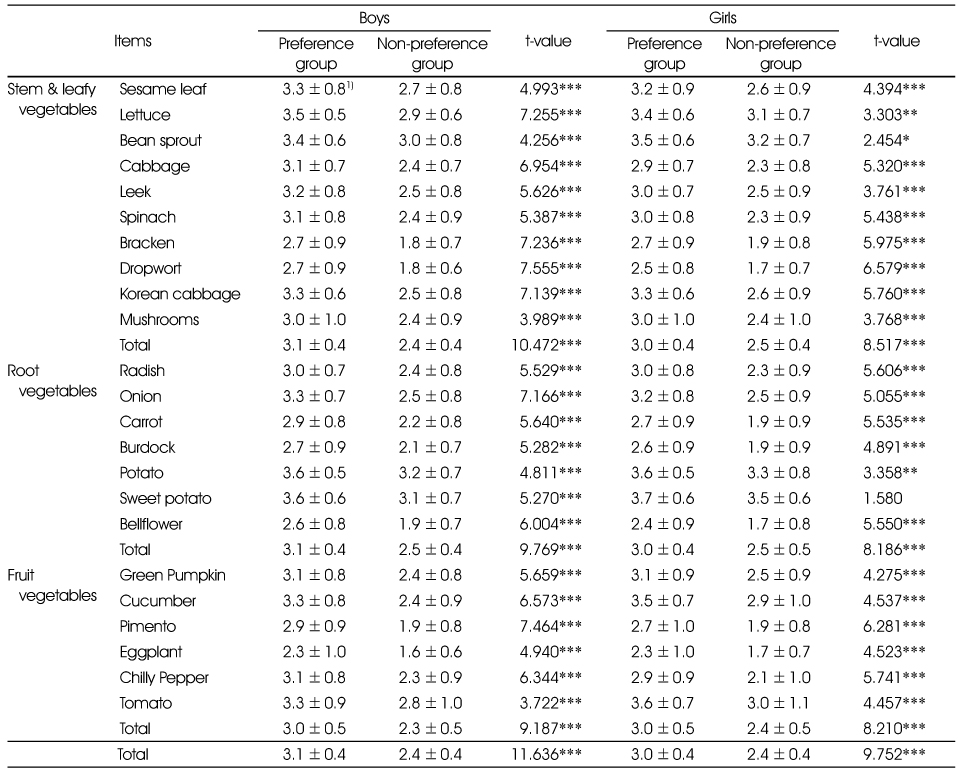

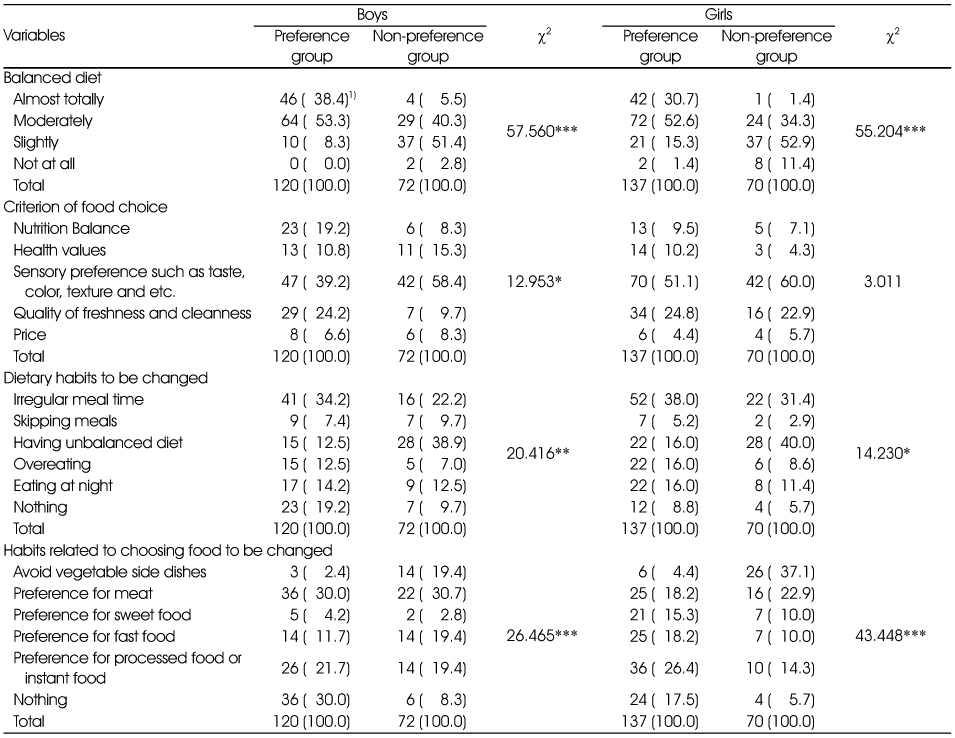
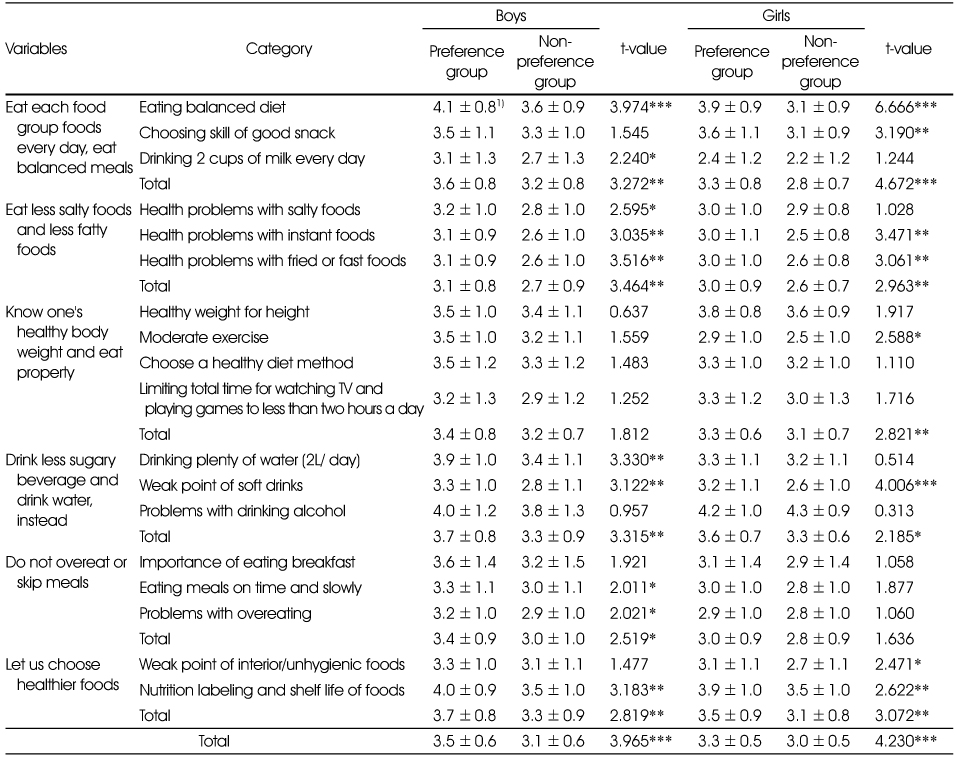

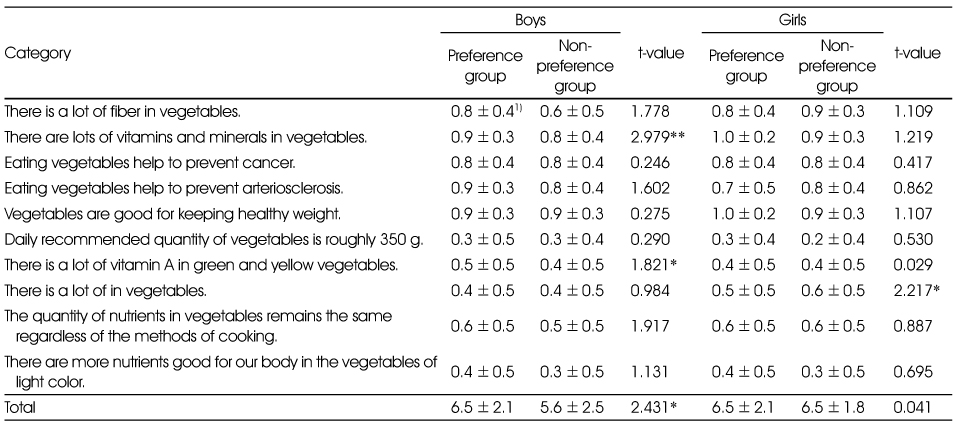
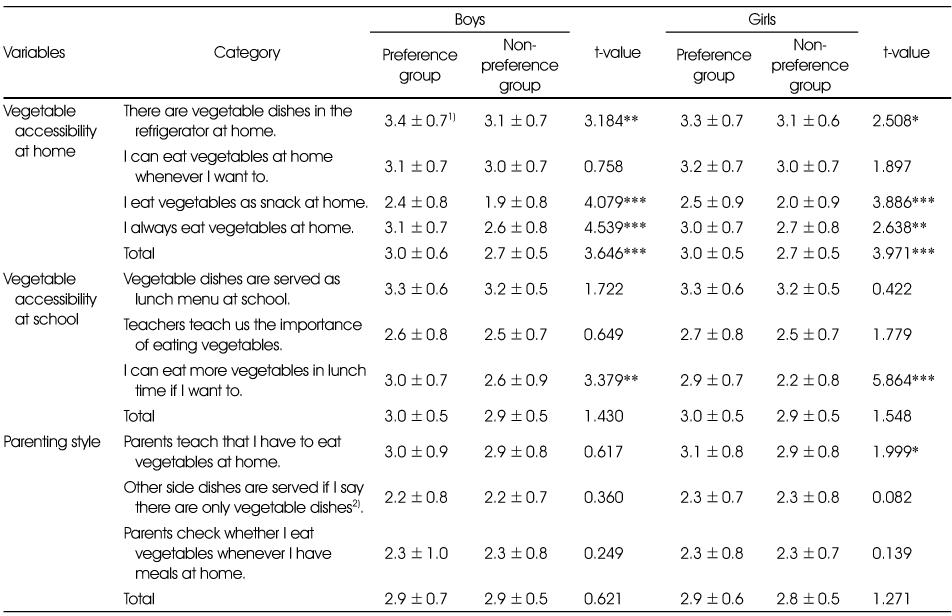
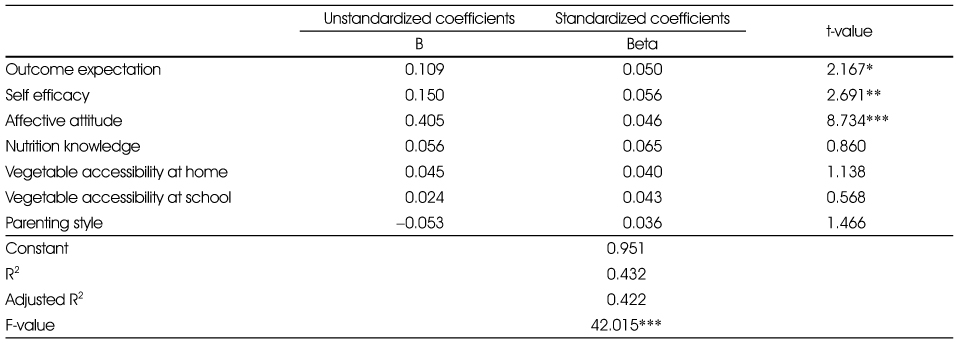
 Cite
Cite


